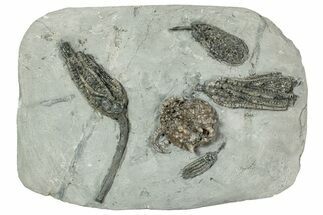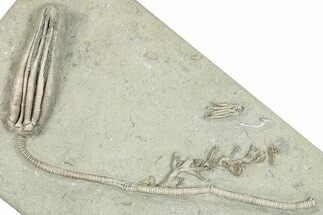This Specimen has been sold.
Rare, 3.55" 3D Crinoid (Platycrinites) Fossil - Ireland
This is a 3.55" long Platycrinites laevis crinoid from the an undisclosed Carboniferous layer in Hook Head, County Wexford, Ireland. The quality of preparation on this fossil is exquisite - using skillful air-abrasion techniques under a stereo microscope. The calyx, arms, and a portion of the column are visible.
The specimen can stand on its own, but we have included an acrylic stand for display options.
The specimen can stand on its own, but we have included an acrylic stand for display options.
Crinoids from the Ramp Creek Limestone were likely buried in sediment from nearby deltas during storms. The resulting siltstone deposits are soft enough that fossils can be extracted in exquisite, three-dimensional relief.
Crinoids, sometimes commonly referred to as sea lilies, are animals, not plants. They are echinoderms related to starfish, sea urchins, and brittle stars. Many crinoid traits are like other members of their phylum. Such traits include tube feet, radial symmetry, a water vascular system, and appendages in multiples of five (pentameral). They first appeared in the Ordovician (488 million years ago) and some species are still alive today.
Crinoids, sometimes commonly referred to as sea lilies, are animals, not plants. They are echinoderms related to starfish, sea urchins, and brittle stars. Many crinoid traits are like other members of their phylum. Such traits include tube feet, radial symmetry, a water vascular system, and appendages in multiples of five (pentameral). They first appeared in the Ordovician (488 million years ago) and some species are still alive today.
SPECIES
Platycrinites laevis
LOCATION
Hook Head, County Wexford, Ireland
SIZE
Crinoid: 3.55" long, Rock: 5.9x 3.55"
CATEGORY
SUB CATEGORY
ITEM
#206484
We guarantee the authenticity of all of our specimens.
 Reviews
Reviews












